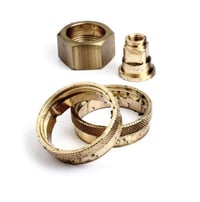Washing Challenging Parts is Easier with Vacuum Chamber Washers
Removing all cutting fluids and chips from finished parts can present a challenge. If you want to effectively find the best method and chemistry for parts washing, you must find a solution that will fully wash your parts in one cycle and rinse and dry them in a given timeframe, which can be difficult.
 Challenging parts can prevent the solvent from flushing hard-to-reach areas in the part, leaving contamination behind in crevices and indentations. If you’re using an aqueous system, the parts in the center of the basket might be so heavily packed with each other that they remain unrinsed or undried, requiring either multiple cycles or a machinist to manually blow air through each part individually.
Challenging parts can prevent the solvent from flushing hard-to-reach areas in the part, leaving contamination behind in crevices and indentations. If you’re using an aqueous system, the parts in the center of the basket might be so heavily packed with each other that they remain unrinsed or undried, requiring either multiple cycles or a machinist to manually blow air through each part individually.
So, when it comes to bulk wash cycles, what is considered a challenging part? If your parts fall into any of these categories, they might be difficult to wash:
- Parts with small, deep or blind holes
- Parts with internal grooves and recesses
- Parts with intersecting holes
- Parts with tapped holes
- Die-cast parts
- Parts with cavities
- Medical and dental parts
- Critical assembly housings
- Stamped and formed parts
- Tubular parts with compound bends
- Parts assemblies
 Utilizing a vacuum chamber allows the cleaning solvent to contact all the challenging geometries as there is no air to displace the solution. Additionally, the solvent is prevented from escaping and mixing with the air in your plant. This also allows the solvent to be heated and recycled after cleaning, extending the usable lifespan of the solvent and saving you money in the long run.
Utilizing a vacuum chamber allows the cleaning solvent to contact all the challenging geometries as there is no air to displace the solution. Additionally, the solvent is prevented from escaping and mixing with the air in your plant. This also allows the solvent to be heated and recycled after cleaning, extending the usable lifespan of the solvent and saving you money in the long run.
iFP vacuum chamber parts washers also utilize ultrasonics to break up tougher soils and release them from the interiors of parts. This ensures a bulk load of clean, dry parts every time without manual rework.

